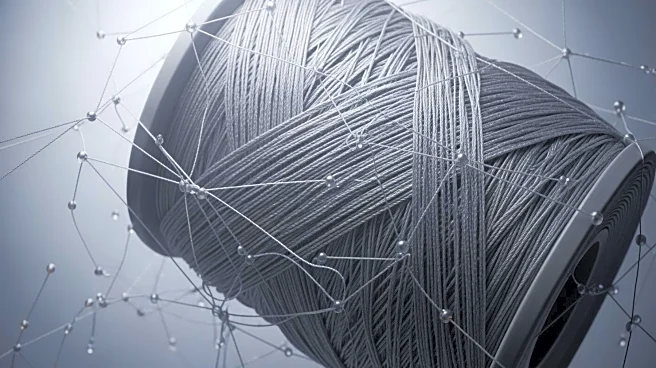What's Happening?
Recent advancements in fiber engineering have led to the development of magnetorheological fibers and fabrics that can actively change shape, stiffness, and motion in response to magnetic fields. This breakthrough, detailed in a study published in Nature,
introduces a scalable method for creating these responsive materials, which are significant for progress in soft robotics, wearables, and human-machine interfaces. Unlike previous systems that relied on rigid elastomers, this approach embeds soft magnetic particles within a flexible polymer matrix, allowing for dynamic and reversible responses. The fibers are produced using a melt-spinning process, incorporating carbonyl iron particles into a low-density polyethylene matrix, and are aligned using nano-computed tomography to ensure high torque response under magnetic fields. These materials are safe for human interaction and can be woven into textiles that exhibit field-controlled behaviors, such as directional bending and stiffness modulation.
Why It's Important?
The development of magnetorheological fibers and fabrics represents a significant advancement in the field of smart textiles, offering new possibilities for interactive garments and surfaces. These materials can enhance next-generation soft robotic systems and human-machine interfaces, providing more dynamic and responsive solutions. The ability to control fabric behavior through magnetic fields opens up potential applications in various industries, including healthcare, sports, and fashion, where adaptive and responsive materials can improve user experience and functionality. Additionally, the scalability of this technology suggests it could be integrated into mass production, making smart textiles more accessible and widespread.
What's Next?
The integration of magnetorheological fibers into functional soft devices is already underway, with prototypes such as a haptic glove and a conformable gripping system demonstrating the potential of these materials. As research continues, further development and refinement of these technologies are expected, potentially leading to commercial applications in virtual interaction, remote manipulation, and adaptive clothing. Stakeholders in the textile and technology industries may explore partnerships to bring these innovations to market, while researchers will likely focus on enhancing the performance and durability of these materials.
Beyond the Headlines
The ethical implications of smart textiles that can interact with users and environments are worth considering. As these materials become more integrated into daily life, questions about privacy, data security, and user consent may arise, particularly in applications involving personal data collection and analysis. Additionally, the environmental impact of producing these advanced materials should be assessed, ensuring sustainable practices are adopted in their manufacturing and disposal.













